STUDIO TAN: MODULATIONS
"Studio tan" is the first of the three releases by Warner Bros., done as a consequence of their litigational conflict with Zappa.
Though released in 1978, the larger part of the recordings stems from 1974-6. It includes recordings by Zappa's rock band as well as by the orchestra of session
musicians he had hired in 1975 for recording "Orchestral favorites". More information about the latter in the previous section.
The subject of modulating is coming by frequently in this study. In this section for instance at track 3 of "Studio tan".
When I'm calling something a modulation in this study is briefly described at the bottom of the Burnt weeny sandwich section.
As it comes to modulations, one has to distinguish between three areas in Zappa's music:
- Written diatonic music. Here Zappa modulates often and fast. Sometimes a key is only maintained for one bar. The Burnt weeny sandwich section gives
an overview of the keys being used in all examples in this study. These are just outtakes, not complete songs. Even then you can see that modulations
are happening in most of Zappa's songs. The "Lemme take you to the beach" track from "Studio tan", described below, is just one of many.
It can also happen that Zappa is switching that fast, often not using all notes of a scale,
that it is getting difficult to identify this as modulations in a meaningful way. Situations with series of fragments from different scales happen in pieces as "Sad Jane".
In this study I've resorted to calling this "multi-scale", rather than try to identify each little section.
- Improvised diatonic music. Most improvised examples in this study are guitar solos, with Zappa soloing himself. Other than in his written
music, Zappa preferred to stay in one key when soloing. This topic is being dealt with at large in the Shut up 'n play yer guitar, Guitar and Trance-Fusion
sections.
- A substantial part of Zappa's music is atonal. Here the term modulation by definition doesn't apply.
One can also distinguish between types of modulations in Zappa's output:
- The mingling of two closely related scales with the same key-note. This happens frequently. It's a subtle way of modulating that goes that smoothly, that
listeners are probably hardly aware of this taking place. It's more something you notice when transcribing material. You've got a couple of combinations
of scales, that differ only by one note. In many examples you can see that this note turns up as natural as well as sharp or flat, without a good reason
to call one of these two appearances altered. So in this study I identify this as both scales happening. The Guitar section gives an overview of such examples.
Related to this are
situations, where the note that makes the difference is avoided or absent. Sort of a six-tonic situation.
In the latter case it remains unclear which specific scale is being used.
For lack of anything better I also list these as both possibilities taking place (the absent note could be natural, sharp or flat).
- Changing a key by changing the pedal note, while the same set of notes keeps being used. This is also a smooth, rather easy way of modulating,
but one you can directly hear. This can be taking place within a song but also between different versions of a song.
- Modulating to relatively related scales by altering one or a few notes, often in combination with a change of the key note. This is the standard, classical way
of modulating. In harmony classes you are taught how to make such modulations sound fluid. You can look for a pivot chord, a chord that belongs to two
subsequent keys. Or you can alter a note in a chord and then continue with the scale that includes this altered note. This classical form is also
in Zappa's music happening quite a lot, though he didn't find it necessary to look for the most fluid transitions.
- Modulation schemes. When a series of modulations returns identically during a piece, you can call this a modulation scheme. The last example above includes
a C-Ab-G-C scheme. Other examples can concern schemes for how a band should improvise. This is happening in the "Fifty-fifty" and "Blessed relief" examples
from this study.
- Modulating to relatively unrelated scales. Doing this overnight is in harmony classes seen as an error. You are expected to play a number of transitory chords,
before you can continue with the new unrelated scale. Here Zappa's attitude can be called deviant. He does make such modulations in a blunt manner and apparently
liked the harmonic surprise effect it causes. Examples in this study are for instance "Uncle meat" (transition from theme 1 to theme 2) and "Would you like a snack?".
- Something he also frequently does is using material from different diatonic scales in a rather fragmented way as in "Sad Jane" or the third theme from "Uncle meat".
Such effects can also be caused by playing chord types parallel. It's switching between scales, but it doesn't get referred to as modulating in a classical manner
any more. It sometimes gets described as taking tonality to its limits or moving towards chromaticism/atonality.
Some examples in this study with parallel movements of chord types: "Hungry freaks, daddy", "Who are the brain police?", "Son of Suzy Creamcheese" (9/8 bar),
"Let's make the water turn black", "The idiot bastard son", "Dinah-Moe Humm" and "Five-five-FIVE".
1. Greggery Peccary
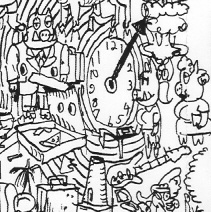 From the start of his career Zappa was interested in combining music and literature in the shape of opera's, movies and
stories set to music. In 1964 he was busy with the little opera "I was a teenage maltshop" and the "Captain Beefheart vs. the Grunt
people" movie. Both projects remained unfinished. Such ideas of combining music and texts exist in classical music in various
forms as for instance in symphonic poems, but are rare in rock music. Zappa did two stories
put to music as one bigger piece, namely "Billy the mountain" from "Just another band from L.A." and "Greggery Peccary"
from "Studio tan". Both have one ongoing story, but musically they are constructed completely different. Whereas "Billy
the mountain" has central returning themes, "Greggery peccary" is a sequence of some 25 short individual compositions,
which are mostly unrelated. Both pieces have their advantages and disadvantages. "Billy the mountain" is the
better unity, but "Greggery Peccary" has far more music to it. There are quite some things that Zappa did once and
only once in his career and "Greggery Peccary"
is one of them. Included below are six fragments, partially transcribed, partially parts from the original score. The first one is the opening theme, that returns
twice. It's a mix of diatonic material from various scales and chromatic movements.
The last one includes the New brown clouds central theme in G, that lasts 10/8 and gets repeated three
times over a two-bar vamp in 6/8. So you get these two melodies gliding over each other.
Image to the right: part of the 1995 drawing by Gary Panter for the current CD release, copyright ZFT.
From the start of his career Zappa was interested in combining music and literature in the shape of opera's, movies and
stories set to music. In 1964 he was busy with the little opera "I was a teenage maltshop" and the "Captain Beefheart vs. the Grunt
people" movie. Both projects remained unfinished. Such ideas of combining music and texts exist in classical music in various
forms as for instance in symphonic poems, but are rare in rock music. Zappa did two stories
put to music as one bigger piece, namely "Billy the mountain" from "Just another band from L.A." and "Greggery Peccary"
from "Studio tan". Both have one ongoing story, but musically they are constructed completely different. Whereas "Billy
the mountain" has central returning themes, "Greggery peccary" is a sequence of some 25 short individual compositions,
which are mostly unrelated. Both pieces have their advantages and disadvantages. "Billy the mountain" is the
better unity, but "Greggery Peccary" has far more music to it. There are quite some things that Zappa did once and
only once in his career and "Greggery Peccary"
is one of them. Included below are six fragments, partially transcribed, partially parts from the original score. The first one is the opening theme, that returns
twice. It's a mix of diatonic material from various scales and chromatic movements.
The last one includes the New brown clouds central theme in G, that lasts 10/8 and gets repeated three
times over a two-bar vamp in 6/8. So you get these two melodies gliding over each other.
Image to the right: part of the 1995 drawing by Gary Panter for the current CD release, copyright ZFT.
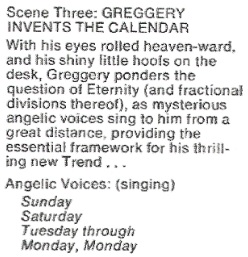 The sequence of the little compositions in this piece generally goes as below, and can roughly be grouped into
a couple of blocks. That is to say if you follow the musical styles and themes on "Studio tan" in combination with the subdivision
Zappa himself apparently used for his scores. In 2007 the ZFT released
"Wazoo" with a booklet, written by Zappa himself, that includes the plot as it existed in 1972 (sample to the right). "Greggery Peccary"
was first designed as a little ballet, divided into six scenes. Zappa at that time give it little chance of being realized. In this
particular form "Greggery Peccary" indeed didn't get staged, though it needs little imagination to visualize the narration
from "Studio Tan" in your mind. For the Wazoo tour he took out four pieces of music separately. Doing so it has thus become entirely instrumental
on "Wazoo" and the correspondence of the sections on that CD with "Studio tan" is added below.
The "Swifties, such big swifties..." part originally stems from "Farther O'blivion", another 1972 composition, as released on "Imaginary diseases". See
the corresponding Imaginary diseases section for the brass band set-up of this piece from that year. It turns out that the size of the blocks, as played on
"Studio tan", eventually has become disproportional. Block III is very small compared to block I. It looks like the "Swifties, such big swifties..." section, part of block I,
got inserted into the play later on.
The sequence of the little compositions in this piece generally goes as below, and can roughly be grouped into
a couple of blocks. That is to say if you follow the musical styles and themes on "Studio tan" in combination with the subdivision
Zappa himself apparently used for his scores. In 2007 the ZFT released
"Wazoo" with a booklet, written by Zappa himself, that includes the plot as it existed in 1972 (sample to the right). "Greggery Peccary"
was first designed as a little ballet, divided into six scenes. Zappa at that time give it little chance of being realized. In this
particular form "Greggery Peccary" indeed didn't get staged, though it needs little imagination to visualize the narration
from "Studio Tan" in your mind. For the Wazoo tour he took out four pieces of music separately. Doing so it has thus become entirely instrumental
on "Wazoo" and the correspondence of the sections on that CD with "Studio tan" is added below.
The "Swifties, such big swifties..." part originally stems from "Farther O'blivion", another 1972 composition, as released on "Imaginary diseases". See
the corresponding Imaginary diseases section for the brass band set-up of this piece from that year. It turns out that the size of the blocks, as played on
"Studio tan", eventually has become disproportional. Block III is very small compared to block I. It looks like the "Swifties, such big swifties..." section, part of block I,
got inserted into the play later on.
I. A. Greggery on his way to office.
This block opens with the "Greggery Peccary" theme, that returns twice.
It's about all modern music in this block.
- 0:00 "Greggery Peccary" theme (Wazoo: Mvt. I, 0:00-0:17).
Greggery Peccary, opening bars (midi file).
Greggery Peccary, opening bars (transcription).
- 0:18 Introduction of "Greggery Peccary" with modern music (Wazoo: Mvt. I, 0:18-1:29, only some motifs correspond).
- 1:08 Modern instrumental section I.
In 2021 and 2022 Josh Oxford contacted me for sharing scores and a dissertation he has written, called "Scrutinizing Frank Zappa's "The adventures of Greggery Peccary"".
It's available through this link for his page on the ProQuest site.
On page 45 a large example of 42 bars can be found with the lead melody from this section. I've included this example below as well as an adaptation of the first
30 bars to how they are played on "Studio tan". Josh presents it with the title "Some ballet music" and indeed this melody can also be heard during the first three minutes of
"Some ballet music", first on a flute and next by the band, though not identically. The Mothers played "Some ballet music" live in 1969,
only known via the "At The Ark" bootleg from the "Beat the boots" series. On "Studio Tan" it's played as a piece of chamber music with members from the 1975 Orchestral favorites orchestra playing most parts. The lead melody dominates, while the others
parts contribute harmony notes and occasionally small counterpoint movements. The only rock-band element in it are the chords from bars 5-6.
Greggery Peccary, 0:50-1:51 (midi file).
Greggery Peccary, 0:50-1:51 (score/transcription).
As also noted by Josh, various forms of compositional techniques can be discerned in this section, as there are:
- Augmentation of intervals as during bars 3, 25 and 26.
- Transposing a figure upwards or downwards as done during bars 9-10 and 27-30.
- Both during bars 13-14.
- Letting material return and getting varied upon. Bar 1-2 and bars 7-8 start alike and end differently.
Likewise bar 13 starts as bar 3, continuing differently.
- Returning rhythmic patterns as strings of eighth notes at the beginning and strings of 16th notes during the second half,
while bars as 17 through 22 are breaking these patterns.
- 2:28 "Greggery Peccary" theme, variation I (Wazoo: Mvt. I, 1:30-1:38).
- 2:38 Modern instrumental section II (Wazoo: Mvt. I, 1:39-2:38).
- 4:08 "Greggery Peccary" theme, variation II.
- 4:15 Narration about trendmongers with modern music.
- 4:49 Narration about trendmongers continues with a medley.
- 5:17 Modern instrumental section III.
The following fragment contains the opening bars of this section that Zappa had introduced earlier as "Join the march and eat my starch"
on the "Piquantique" bootleg and "The crux of the biscuit" in a different context.
It's modern atonal music in 7/8 with two- and three-part counterpoint. Like the opening theme it's a mix of diatonic material from various scales and chromatic movements.
Greggery Peccary, 5:17-5:25 (midi file).
Greggery Peccary, 5:17-5:25 (transcription).
On "The crux of the biscuit" this section is played at the end of the "Don't eat the yellow snow" suite, recorded in June 1973 in Sydney. The example below
contains bars 1-5, corresponding with 18:53-19:00 on this track. On "Piquantique", recorded in August 1973 in Stockholm, it's played as a prelude to
"Farther O'blivion", with these bars to be heard between 0:02 and 0:10. In the Wazoo section you can find the opening of the "Farther O'blivion" score, showing it wasn't part
of the actual composition, nor is it likely it was ever part of a "Don't eat the yellow snow" score.
Join the march and eat my starch (Sydney), bars 1-5 (midi file).
Join the march and eat my starch (Stockholm), bars 1-5 (midi file).
Join the march and eat my starch, bars 1-5 (transcriptions).
These two 1973 performances are largely the same as it comes to the upper marimba part and lower bass part.
The voices in between include trombone, trumpet and violin at Sydney, and just the trombone
at Stockholm. In 1975, for "Studio Tan", Zappa arranged this piece anew. My guess is that there was an improvisation element to the middle voices in 1973, while
in 1975 all got written out. The bass and the figure from bars 1 and 5 were kept basically the same, but the melodic lines
and harmonies of the other bars/parts sound pretty different. At the Musescore.com site you can find another arrangement of this piece. The transcriber
comments that he or she took the Stockholm performance as the basis, mingling it with material from "The crux of the biscuit" and "Studio Tan".
The lead melody seems to be based upon the Stockholm performance.
I. B. Big Swifty and associates. This block is rock music throughout.
- 5:52 A normal rock vamp with Zappa talking.
- 6:23 "Swifties, such big swifties...", pop themes.
- 7:42 Second rock vamp with Greggery taking over the narration.
- 8:06 "We've got the little answers...", pop themes.
- 8:31 Third rock vamp with a text about inventing the calendar.
II The response to the calendar. This part has no specific musical tendencies; it's the story about
how people are affected by the calendar with all kinds of styles.
- 9:06 "Sunday, Saturday...", narration with modern music (Wazoo: Mvt. II).
Greggery Peccary, opening bars from mvt. II, 9:10-9:23 (midi file).
Greggery Peccary, opening bars from mvt. II, 9:10-9:23 (score/transcription).
- 10:21 "Unfortunately some people...", narration with a medley of rock phrases.
III Instrumental interlude.
- 12:33 Modern instrumental section IV mixed with jazz (Wazoo: Mvt. III).
Greggery Peccary, opening bars from mvt. III, 12:33-12:47 (midi file).
Greggery Peccary, opening bars from mvt. III, 12:33-12:47 (score/transcription).
IV New brown clouds. This part has a central "New brown clouds" riff and theme.
- 14:52 "New brown clouds" riff with narration (Wazoo: Mvt. IV, 0:00-0:38).
- 15:32 "New brown clouds" main theme (Wazoo: Mvt. IV, 0:39-0:52).
- 15:48 Rock progression with Greggery calling a philosopher (Wazoo: Mvt. IV, 0:53-1:22).
- 16:22 Zappa takes over introducing Quentin Robert Denameland.
- 16:45 Quentin speaks with some modern music (Wazoo: Mvt. IV, 1:23-2:35, only some motifs correspond).
- 17:07 "New brown clouds" riff with a mix of modern music and jazz (Wazoo: Mvt. IV, 2:35-3:28).
- 18:00 Modern instrumental section V, the riff has vanished and the modern music continues (Wazoo: Mvt. IV, 3:28-4:28).
- 19:04 "New brown clouds" variations (Wazoo: Mvt. IV, 4:28-6:05, its coda has some extra bars).
Greggery Peccary, New brown clouds, fragment (midi file).
Greggery Peccary, New brown clouds, fragment (transcription).
It sometimes happens that I come across the original score after I've included a transcribed example. Or that another recording sets
a composition in a new perspective. Both happened with "The new brown clouds". The Wazoo CD by the ZFT contains an earlier
version without lyrics for a big band. See the corresponding section for much more about
"The new brown clouds (1972)".
The example above contains the main riff and main theme, preceded by Zappa talking: "make your checks payable to Robert
Quentin Denameland" etc.
- 20:34 End.
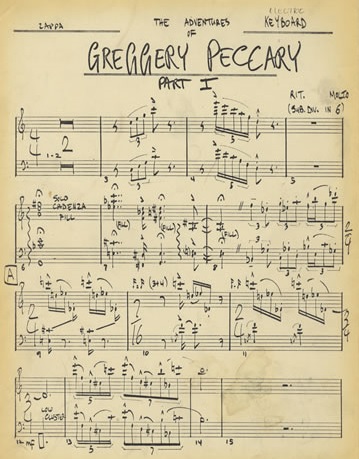 On the internet you can frequently encounter examples of original handwritten scores, that Zappa handed over to band members or orchestra members.
To the right the first page of the keyboard part of movement I.
Apparently he didn't ask these scores to be returned systematically, even handwritten orchestra sheets. So he must have written a number of specimens
of each score. It shows how time-consuming writing music must have been when there weren't computers or decent copy machines. In this case I could find
samples from the keyboard and trombone scores, that have been used above. It's more a rule than exceptional that recordings differ from the sheet music.
This can get confusing, both from the analytical point as for how exactly a piece should be performed. Regarding the "Studio tan" version, the keyboard
part from the example from mvt. II is only included during bars 1-3 and the trombone part is absent altogether. It's clear one might add the total keyboard part,
but I can't tell if this can be done for the trombone part too. Possibly it got substituted. On "Wazoo" it's the other way round. The trombone is present and
the keyboard is absent.
If you would play the keyboard and trombone part separately
for bars 1-11, you would get at the following midi file (see the example above for the score).
On the internet you can frequently encounter examples of original handwritten scores, that Zappa handed over to band members or orchestra members.
To the right the first page of the keyboard part of movement I.
Apparently he didn't ask these scores to be returned systematically, even handwritten orchestra sheets. So he must have written a number of specimens
of each score. It shows how time-consuming writing music must have been when there weren't computers or decent copy machines. In this case I could find
samples from the keyboard and trombone scores, that have been used above. It's more a rule than exceptional that recordings differ from the sheet music.
This can get confusing, both from the analytical point as for how exactly a piece should be performed. Regarding the "Studio tan" version, the keyboard
part from the example from mvt. II is only included during bars 1-3 and the trombone part is absent altogether. It's clear one might add the total keyboard part,
but I can't tell if this can be done for the trombone part too. Possibly it got substituted. On "Wazoo" it's the other way round. The trombone is present and
the keyboard is absent.
If you would play the keyboard and trombone part separately
for bars 1-11, you would get at the following midi file (see the example above for the score).
Greggery Peccary, keyboard/trombone part of the opening of mvt. II (midi file).
What you can see is that this movement starts with rather abstract atonal music with varying meters. Relationships are established by for instance returning motifs
(bars 1-2 and bars 10-11) and variations. Bar 6 is a variation upon bar 5 at double speed, created by meter change from 5/8 to 5/16. Rhythmic diversity
exists horizontally. Vertically the parts are mostly following the same rhythm, the bass from bar 6 being an exception. On the album a tiny
intro got added (9:06-9:10), with the chorus and Greggery singing/saying "Sunday, Sunday, wow", that isn't indicated in the score.
In case of the opening of movement III, the CD version does use the keyboard and trombone part as they are. The only substantial difference
is the insertion of an extra 16th note in bar 9, becoming 8/16 as 2+3+3 by doing so instead of 7/16 as 1+3+3. Also this opening is abstract atonal music with varying meters.
Still there are more version differences. In May 2018 John Tabacco wrote me saying: "There is a version FZ played of "Greggery Peccary" where the philos(t)opher is referred to
as Quentin Robert Denameland greatest living "two headed" philostopher known to mankind. The dialog that is on "Studio tan" has
been severely edited out. It goes on quite a bit longer and fits in tandem to the music that is going on. I don't know why FZ cut it out but
it really makes the whole movement make more sense." And: "As you know many of the parts on Greggery Peccary date
back to the sixties and were performed with the Petit Wazoo band in 1972.
That being said, the excerpt [mentioned below] was recorded in mono off the radio on
April 18th, 1975 at Connecticut radio station WPLR. The rest of the work is pretty much the same up to the philosopher part. FZ added a few
more overdubs on the "Studio tan" version but nothing too significant. Zappa and Beefheart were the guests and he played a variety of
then unreleased material. This version of Greggery Peccary was one of them. The other oddity played was the full blown "200 Years old" which featured a
lot more of George Duke's excellent piano skills. I suspect FZ edited it down to 4 minutes because it would have made
side one of Bongo Fury a little too long and thus diminish the audio fidelity. I doubt there is any other reason because the unedited version is great."
An otherwise unknown song from these radio broadcasts is "Will you drink my water", introduced by Zappa as a song by the "Smegmates". It's a little collage.
These files from radio broadcasts from 1975 can be found on internet as:
- Original Greggery Peccary.mp3
- 200 years old (unedited).mp3
- Will you drink my water.mp3
2. Music for low budget orchestra
"Studio tan" was recorded during 1974-1975 with pieces by the rockband and
sections with the above orchestra. The next examples stem from the introduction to "Music
for a low budget orchestra". The chronology of this piece goes as follows:
- Composed in the late sixties at the time of the "Lumpy gravy" sessions.
- Premiere recording on a Jean-Luc Ponty album of 1970 (Jean-Luc Ponty plays the music of Frank Zappa).
- In 1971 the intro was part of the touring program with Ian Underwood playing the melody on clarinet.
- The score of the intro is published in 1973 in The Frank Zappa songbook, vol. I (1971 touring version).
- In 1975 it was recorded in total in the studio by a small orchestra
plus some electric instruments (the same ensemble that did the "Orchestral favorites" tracks).
- This 1975 recording premiered on the 1978 release "Studio Tan", the official Zappa version.
- The 1971 live version of the intro became included in "Playground psychotics" in 1992.
- The complete score is nowadays available via Barfko Swill (see the scores section). The Ensemble Modern included
this piece in their 2003 CD "Greggery Peccary and other persuasions".
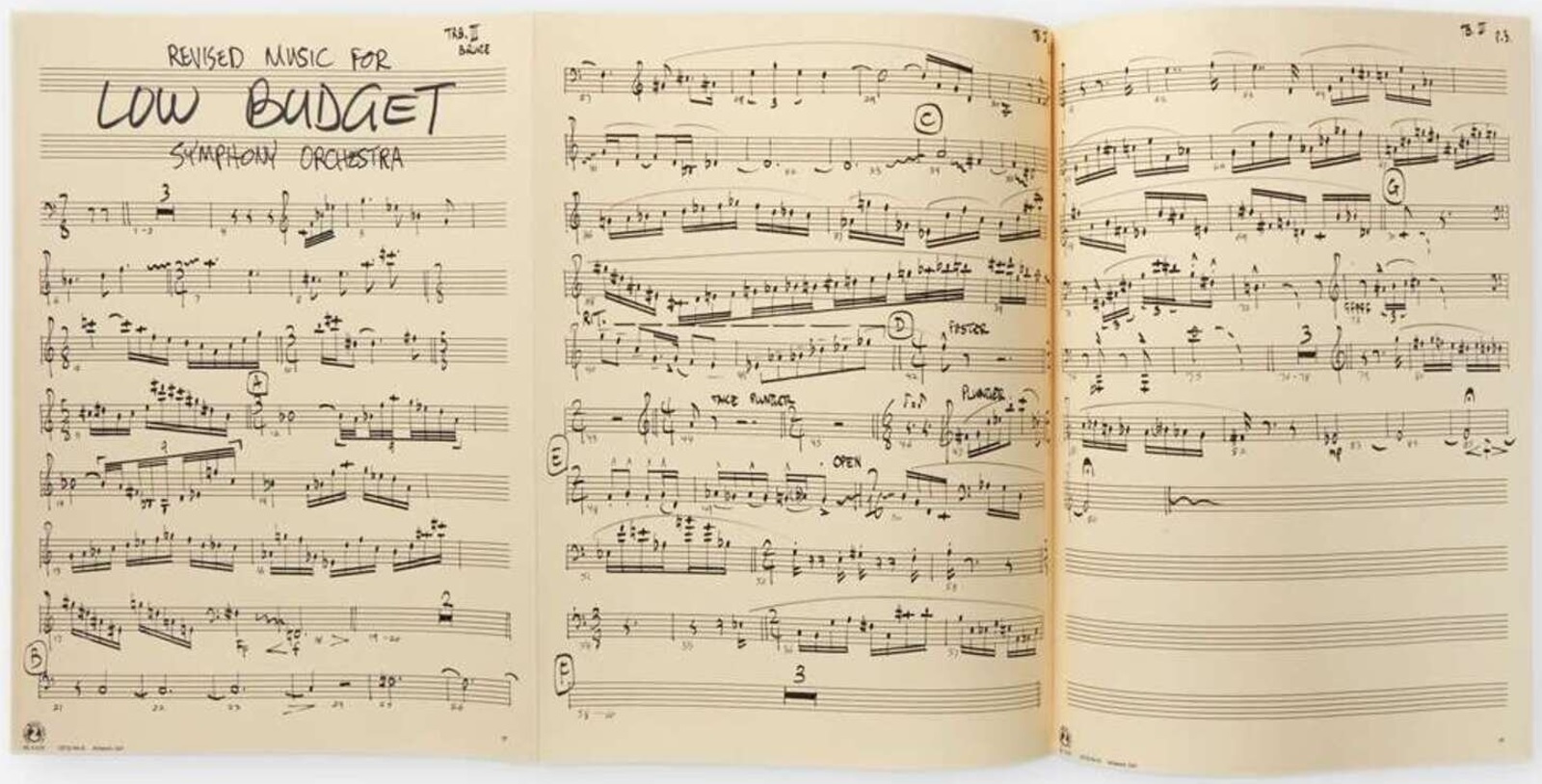
The trombone II part (written for Bruce Fowler) shows how Zappa originally had subdivided this composition into sections A through G.
By comparing it with the album, one can notice a lot got added to it for the final album version.
0:00: Bars 1-11. Intro.
Music for low budget orchestra (Orchestra version), bars 1-10 (midi file).
Music for low budget orchestra, bars 1-10 (notes).
0:20: Bars 12-20. Section A.
Music for low budget orchestra (Playground psychotics), bars 9-15 (midi file).
Music for low budget orchestra, bars 12-14 (notes).
The opening bars of "Revised music for low budget orchestra" contain a lead melody, played over enlarged chords.
In the Songbook these chords for bars 1-14 are notated as the following progression (with the bass pedal notes as tonic):
- bars 1-6: Bb Mixolydian with Bb13.
- bars 7-8: B minor with B11(-13).
(Zappa's score and the piano part in the Songbook don't use D/D#, so B minor is the standard diatonic scale being applied.
The guitar chord B11(-13) in the Songbook is getting voiced as F#-B-F#-A-D#-F#. Played like that it doesn't follow a standard
diatonic scale, but a major type of scale).
- bar 9: C Mixolydian with C13.
- bar 10-11: C# minor or Dorian with C#m7add6.
- bars 12-14: D Phrygian with D+7(b9).
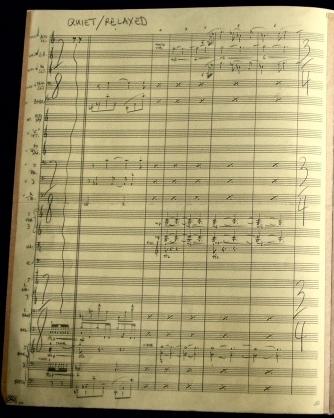 They are played in the manner of the second
example above (on CD: the "Playground psychotics" version). Zappa's handwritten orchestra version (sample of bars 1-6 to the right) spreads these same chords out over
the orchestra. This orchestra is made up of 22 parts, a normal size. The term low budget can be explained by the fact that
there's only one member per part instead of sections. So you don't hear a string section on "Studio tan" but a string
quartet. The score to the right was auctioned on internet recently and probably stems from the "Orchestral favorites"
sessions. It's in Zappa's handwriting. For the actual performance on the album however, he eventually decided to strip down the score to its basics,
being the lead melody plus drumset. So this sheet version in this specific form hasn't been available on album yet. It
really sounds orchestral this way. The
version that the Ensemble Modern is playing comes nearest (included in their "Greggery Peccary and other persuasions" CD
from 2003). That one however is an Ali N. Askin arrangement of the original
score, done specifically for this ensemble.
The second example stems from "Playground psychotics".
The bars in this case contain two ninetuplets. It's a jazz
styled figure with the piano playing a series of eight notes just behind the third beat of the
accompaniment. These bars are the 1971 version from "Playground psychotics" as printed in the Songbook (Ian Underwood on clarinet and with the
keyboard accompaniment).
They are played in the manner of the second
example above (on CD: the "Playground psychotics" version). Zappa's handwritten orchestra version (sample of bars 1-6 to the right) spreads these same chords out over
the orchestra. This orchestra is made up of 22 parts, a normal size. The term low budget can be explained by the fact that
there's only one member per part instead of sections. So you don't hear a string section on "Studio tan" but a string
quartet. The score to the right was auctioned on internet recently and probably stems from the "Orchestral favorites"
sessions. It's in Zappa's handwriting. For the actual performance on the album however, he eventually decided to strip down the score to its basics,
being the lead melody plus drumset. So this sheet version in this specific form hasn't been available on album yet. It
really sounds orchestral this way. The
version that the Ensemble Modern is playing comes nearest (included in their "Greggery Peccary and other persuasions" CD
from 2003). That one however is an Ali N. Askin arrangement of the original
score, done specifically for this ensemble.
The second example stems from "Playground psychotics".
The bars in this case contain two ninetuplets. It's a jazz
styled figure with the piano playing a series of eight notes just behind the third beat of the
accompaniment. These bars are the 1971 version from "Playground psychotics" as printed in the Songbook (Ian Underwood on clarinet and with the
keyboard accompaniment).
0:58: Bars 21-33. Section B.
1:24: Bars 34-41. Section C.
As with "Greggery Peccary" you've got version differences of the same piece. Just the term "revised", that Zappa used on "Studio tan",
indicates that there exists an earlier non-revised version too. Being that as it is, the following examples show three versions
of the same couple of bars. Globally they are the same regarding meter, rhythm, movement and pattern. But at a detail level, there are many differences.
- A transcription from the CD, 1:23 through 1:47. Bars 36-37 are played in a manner that you're hearing a series of varying chords.
- An execution of the piano reduction from the FZ songbook vol. I. Bars 36-37 correspond with bars 28-29 from the Songbook (the difference is caused
by the fact that the bars for acoustic guitars are absent in the Songbook). These two bars comprehend counterpoint movements. The descant melody
is present on the album, but the bass line isn't. It makes these two bars sound significantly different. One is homophonic, the other polyphonic.
- An execution of the keyboard and trombone part of the original score. The keyboard part makes it clear that Zappa instrumentated this piece at least
in two different manners. The orchestral version from above and a more rockband-like or chamber ensemble version. The instrumentation of the keyboard
part is typical of the seventies decade from the previous century. It names classical keyboard instruments next to electric keyboard types from that era.
Because I've only got two parts, I can't tell how it would go in total. What you can see is that the keyboards and trombone are playing bars 36-37
as parallel minor thirds, thus again differently.
Music for low budget orchestra (Studio tan version), bars 34-41 (midi file).
Music for low budget orchestra (Songbook version), bars 34-41 (midi file).
Music for low budget orchestra (keyboards/trombone part), bars 35-41 (midi file).
Music for low budget orchestra, bars 34-41 (score/transcription).
1:46: Bars 42-47. Section D. The Songbook ends with section C. The trombone II part largely pauses during this section, recommencing in bar 47. This
last bar from section D can be heard between 1:57-59.
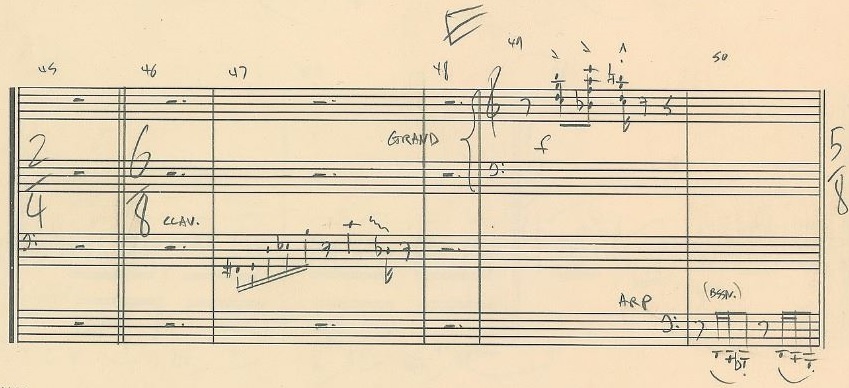
1:60: This is where section E would start. From this point onwards, however, the album proceeds differently, so a lot got added to this composition later on.
Moreover, the trombone part ends with bar 86. When continuing like this it would take up some three minutes in total, while this track takes up 7:35 minutes on the album.
One can also notice that a version of the keyboard part, above these lines, is using meters different from the trombone part at the start of section E.
It looks like this keyboard part corresponds with the album.
Music for low budget orchestra, 3:32-3:53 (midi file).
Music for low budget orchestra, 3:32-3:53 (transcription).
The section above is taken from halfway this composition, belonging to the additions that were done for "Studio tan". It contains:
- Bars 1-4: a three-part counterpoint figure of one bar, repeated three times.
- Bars 5-9: return of the first five bars of the opening theme, orchestrated anew.
- Bar 10: this theme gets broken off by a bar with two chromatic movements, one going up, one going down.
Music for low budget orchestra, 4:26-4:46 (midi file).
Music for low budget orchestra, 4:26-4:46 (transcription).
Between 4:26 and 5:52 you can hear an addition, that sounds as a guitar solo, that has been written out and orchestrated.
Fans can easily recognize the I-II alternation in Lydian, G Lydian in this case, that Zappa used repeatedly for his guitar solos.
The notes on the 1987 promotional cassette "The guitar world according to Frank Zappa" confirmed that this is indeed the case. Bruce
Fowler gets credited for having transcribed the solo and performing the brass overdubs. All of what you can hear on "Studio tan" is
also present on the "Music for low budget orchestra" track from the mentioned "Greggery Peccary and other persuasions" CD, thus
also this solo section. In this case orchestrated by Ali N. Askin with a violin taking care of the guitar part.
"Music for low budget orchestra" belongs to the scores available for rent only at Schott Music. As in some other instances in this study
I transcribed the last two examples from above from the CD, but the effort is rather useless.
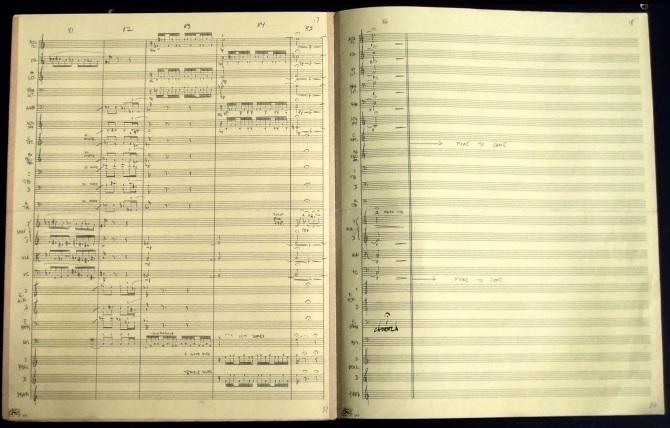
Music for low budget orchestra, end (midi file).
When the orchestra score from above got auctioned, pages 1-2 as well as the two final pages were shown as examples, though only in thumbnail format.
Like the trombone part this orchestra score ended with bar 86. In the midi file I'm trying to play it, but, because of the small format, the pitches of several notes had to be guessed.
It's good enough to recognize that also the album ends like this, namely between 7:22-7:35.
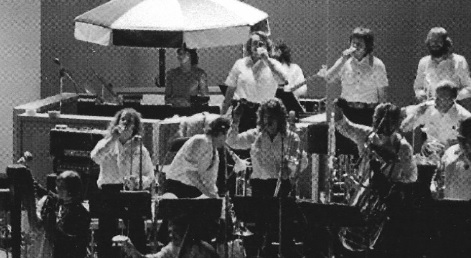
The brass section of the Abnuceals Emuukha Electric Orchestra (outtake of one of the photos by John Williams as reproduced
in the 40th anniversary booklet).
3. Lemme take you to the beach
The lead melody of themes I and II from "Lemme take you to the beach" are present in the Ludwig study on page 269 (see the references), while I've transcribed
part of the interlude with all parts in it.
It's the only piece on "Studio tan"
that you can call a pop-song. At some points it sounds as a pastiche work, at other points it can get pretty volatile. The romantic
lyrics at the beginning with just la-la-la added to it are very unusual for Zappa.
Lemme take you to the beach, opening, lead melody (transcription).
Its construction goes as:
First exposition of themes I-III.
- 0:00 Instrumental opening with a I-II alternation in A Dorian.
- 0:06 Theme I, phrase I, with the accompaniment continuing with the I-II alternation (bars 1-4 from the first transcription).
- 0:13 Theme I, phrase II. The sung melody gets transposed a fourth higher. The accompaniment switches to a IV-II alternation.
- 0:18 Theme II. At this point the song modulates to C. The bass follows steps I-VI-II-V of C. At 0:30 theme II ends with
evading to E Mixolydian (bar 16).
- 0:32 Repetition of theme I with different lyrics.
- 0:44 Theme III. This theme follows a modulation scheme, C-Ab-G-C, the scales thus being a parallel movement of major type of keys.
Most of the time there isn't a complete scale being used. The scales could be called major, but at various points Lydian and Mixolydian just as well.
Like theme II, theme III has a final bar evading to E Mixolydian.
Instrumental interlude.
- 0:57 Theme I, the sung melody now being played instrumentally.
Lemme take you to the beach, section (midi file).
Lemme take you to the beach, section (transcription).
- 1:09 Variation upon theme II. At this point the second transcription
begins. This part is something you could call pastiche-like. The sung melody and the chords form a series of triads and
the meter and rhythm are standard 4/4 with an even subdivision. The bass follows steps I-VI-II-V of C once more (bars 1-7), again ending in E Mixolydian (bar 8).
Next to giving pedal notes, the bass can also play little melody lines by itself in a syncopic manner. There are singers, but with them singing just "la-la-la",
it remains instrumental. This ordinary "la-la-la" accentuates the pastiche effect.
- 1:21 Theme IV with a I 7th - II 7th (plus E) alternation in A Mixolydian at first (bars 9-12). Rhythmically things are getting more complex.
The meters become an alternation of two odd-numbered meters: 7/8 and 9/8. The parts can follow different subdivisions. During bars
13-16 the bass follows steps I-V-IV-V of A Mixolydian.
- 1:34 The modulation scheme with C-Ab-G-C (major type) returns. The final bar 24 modulates to E Mixolydian. This is where the transcription stops.
Return of themes I-II.
- 1:46 Themes I and II return as at the beginning.
Instrumental postlude.
- 2:11 Themes I and III once more.
- 2:33 Coda in C Lydian with a little guitar solo.
- 2:40 Once more the song modulates, now to B minor/Dorian.
- 2:44 End.
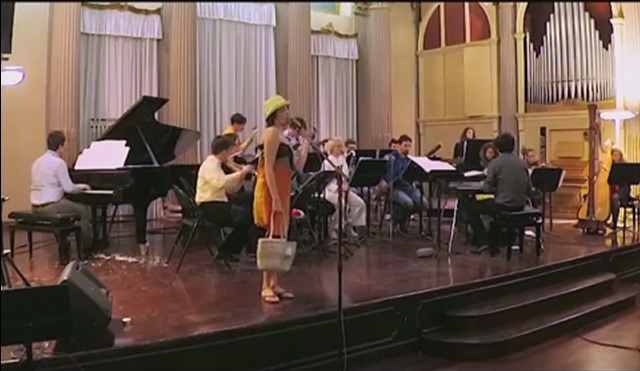
Zappazik! playing "Lemme take you to the beach" in an arrangement for chamber orchestra and vocalist (2017, downloaded from Youtube).
The origins of this song go back to 1969, when its basic tracks got recorded as "Dame Margret's son to be a bride", present on the ZFT release "The Hot rats sessions".
4. RDNZL (1972-8)
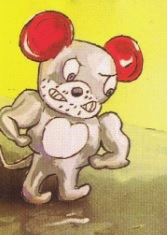 "RDNZL" was written in 1972 and first released on "Studio Tan" in 1978, renamed by Warner Bros. as "Redunzl".
To the right one of the enraged figures Gary Panter drew for the 1978-9 covers. This time a mouse. "Sleep dirt" even includes an enraged lump of dust.
An early studio recording of "RDNZL" is included on "The lost episodes" with Jean-Luc Ponty and Bruce Fowler doing a few solo bars.
Later on the composition became more elaborate and usually included a guitar and a keyboard solo. For the first "complete" version
on record (YCDTOSA vol. II) the song got augmented with a long through-composed melody, following upon the opening theme
as included in the second transcription below. Because of its length it now serves as the main theme.
The larger part of this second main theme got transcribed by Wolfgang Ludwig in his study. The note example below contains
the opening of both the 1974 and 1975 versions. Trying to identify its scales positively is treacherous; it depends upon
how you look at it. One would normally call the 1974 version C major, but since there's no F/F# in it, it could theoretically
also be identified as C Lydian. In the 1975 version Zappa appears to be ambiguous about the F/F# because you can see
a bass pedal F at first and an F# for the harmonies. The F is in dissonance with the opening E of the melody and the F# of the
harmony, so when the bass pedal note becomes A in bar 5 the sounding effect is that of a resolving situation. The chord
progression being Fmaj9 (bar 1) resolving as Am7 in bar 5 by removing the dissonant F. So the feel of it becomes
A Dorian with an F# in its scale. The larger part of the main theme in 1974 is an ongoing stream of eighth notes in 3/4. Yet in 1975 Zappa
changed things again. The melody for the first 8 bars are identical to 1974, but next he had George Duke improvise in a syncopic manner
for eight bars with the originally written material as basis. See bars 9-10 in the transcription to compare things.
After these eight bars the first six bars from the opening return, followed by two new bars to form another
block of eight bars. In this instance the theme is transposed up a major second and the pedal note has become
D. The F/F# ambiguity would lead to a G/G# one, but in the two new bars at the end
you can hear a G at 0:46 (1974), so here the song is in D.
"RDNZL" was written in 1972 and first released on "Studio Tan" in 1978, renamed by Warner Bros. as "Redunzl".
To the right one of the enraged figures Gary Panter drew for the 1978-9 covers. This time a mouse. "Sleep dirt" even includes an enraged lump of dust.
An early studio recording of "RDNZL" is included on "The lost episodes" with Jean-Luc Ponty and Bruce Fowler doing a few solo bars.
Later on the composition became more elaborate and usually included a guitar and a keyboard solo. For the first "complete" version
on record (YCDTOSA vol. II) the song got augmented with a long through-composed melody, following upon the opening theme
as included in the second transcription below. Because of its length it now serves as the main theme.
The larger part of this second main theme got transcribed by Wolfgang Ludwig in his study. The note example below contains
the opening of both the 1974 and 1975 versions. Trying to identify its scales positively is treacherous; it depends upon
how you look at it. One would normally call the 1974 version C major, but since there's no F/F# in it, it could theoretically
also be identified as C Lydian. In the 1975 version Zappa appears to be ambiguous about the F/F# because you can see
a bass pedal F at first and an F# for the harmonies. The F is in dissonance with the opening E of the melody and the F# of the
harmony, so when the bass pedal note becomes A in bar 5 the sounding effect is that of a resolving situation. The chord
progression being Fmaj9 (bar 1) resolving as Am7 in bar 5 by removing the dissonant F. So the feel of it becomes
A Dorian with an F# in its scale. The larger part of the main theme in 1974 is an ongoing stream of eighth notes in 3/4. Yet in 1975 Zappa
changed things again. The melody for the first 8 bars are identical to 1974, but next he had George Duke improvise in a syncopic manner
for eight bars with the originally written material as basis. See bars 9-10 in the transcription to compare things.
After these eight bars the first six bars from the opening return, followed by two new bars to form another
block of eight bars. In this instance the theme is transposed up a major second and the pedal note has become
D. The F/F# ambiguity would lead to a G/G# one, but in the two new bars at the end
you can hear a G at 0:46 (1974), so here the song is in D.
The second section below contains the tail of this main theme, that precedes the guitar
solo. Bars 1-8 are in Ab Major, mingled with Ab Lydian, ending with the Ab major scale being played downwards. The 12/8 is an irregular bar, both in its rhythm
and notes. It's used to switch from the Ab major tail to the guitar solo part, setting the tempo a bit higher. The progression, that accompanies the solo, starts alone gently for 16 bars with the marimba gliding
over it with sustained notes. It's one of Zappa's archetype progressions
of two alternating bass notes/chords, this time in A Lydian combined with major. The accompaniment follows A Lydian, but when
Zappa starts playing he alters the D sharp to D natural, thus using A major for his own solo.
RDNZL, 1975 main theme (midi file).
RDNZL, section (midi file).
RDNZL, 1974 and 1975 main theme (transcription).
RDNZL, section (transcription).
Little is known about how the various Zappa bands learned his songs. Not that it would have been a secret, the band members
just seldom got asked. There a various side remarks in interviews on this topic though. The 1972 Wazoo band and the 1972-74
Roxy band were reading bands, so here Zappa scored out relatively a lot. Every once in a while you can encounter pages of handwritten
scores that Zappa handed out being sold on internet. For his rock bands Zappa usually scored out a lead sheet with the main
melody without instrumentation. The chords are sometimes written out in dots, sometimes indicated by their symbols. The bass
can also be written out, but is mostly indicated by pedal notes. For the above first example from Greggery Peccary
you can see that for the Wazoo band Zappa wrote his scores per instrument, as for an orchestra. The trombone part for
Greggery Peccary, corresponding to the four 1972 movements, is one of the examples I found being auctioned at Christies.
Zappa didn't require that all of his band members could read scores, so the normal way of learning a song in rock music got
applied just as well. That is learning a piece via demos, yet existing recordings and verbal instructions. The bigger and
more elaborate a composition gets, the more difficult it becomes to use this pop method. It's virtually undoable to learn
the lead melody of the "Black page" without reading notes. Even if there wasn't a "Drowning witch interlude" being sold
by the ZFT, you'd know that the score must exist.
There must be hundreds of sheets with sketches and neatly scored out pieces in Zappa's closets. A bewildering thing
to notice is that for the first executions of his music, he frequently started adapting the score. There are many
examples in this study showing how the first recording can deviate from the original score. See the Uncle meat section at King Kong and the following example.
RDNZL, opening bars (draft version) (midi file).
RDNZL, opening bars (Lost episodes) (midi file).
RDNZL, opening bars (notes).
The differences between the two versions are:
- The opening bars 5-12 are two chords in a varying rhythm in the original score. On "The lost episodes", with the first
1972 execution, these opening bars are now an arpeggio chord with harmony fill-in by Ruth Underwood on percussion.
- The whole opening melody in the original score is a sequence of enlarged chords. All chords are 9th chords or bigger,
avoiding the minor second, so that they are never getting sharply dissonant.
The opening bars are in D Mixolydian. From bar 13 onwards the scales keep changing per meter.
On the "Lost episodes" these chords are reduced to three notes per chord, played via three individual parts. The descant
plays the upper notes, whereas the bass guitar plays the lowest notes. The saxophone picks out one of the notes in the middle
voices, though not consistently from the same position. Zappa could easily have had George Duke play the notes exactly as
notated on keyboard as well, but apparently chose not to do so.
- The score indicates the tempo as fast without a metronome number. There are circumstantial indications that suggest
that the opening is played faster than Zappa had in mind at fist. About the whole score is written in 3/4, the tempo
going halfway from fast to slow, lyrical. The difference between these two tempos on record is thus big that two meters,
3/8 and 3/4, seem more logical. Secondly the tremolo in bars 29-32 is notated with 32nd notes. That's undoable with
the tempo on "The lost episodes".
The notation in 3/4 for the opening theme, with all the dotted notes, may look awkward on paper. Zappa seldom scored out
drum parts ("The black page drum solo" is an exception), his meters however indicate how the beats should fall for the drummer:
3/4 in this case. I made some notational mistakes at the beginning for not recognizing this in full, as in "Echidna's arf".
From 1974 onwards it gets more to normal 4/4 for the opening bars with an original 3/4 bar becoming one beat. The drummer
now beats 4/4. The tempo for bars 13-28 can get sped up this way from 10 seconds (1972) to 6 seconds (from 1974 onwards). Zappa starts
counting as "one-one-one-one" on "YCDTOSA vol. II". By not saying "one-two-three-four" you can still notice that the band originally
learned it as in 3/4.

Another topic is the element of improvisation. The example above with the opening bars stems from an eight pages "RDNZL" draft version, that I
found on internet. The image above shows the first five pages on a small scale. It's all in Zappa's handwriting. The general set up of this version is
identical to the 1972 execution (the time indications below follow the
"The lost episodes" starting points).
It has a lot of bars in it with room for
improvisation, where Zappa indicates the environment to improvise in in different ways:
- 0:00, bars 1-4: Drum intro, only the number of bars is indicated.
- 0:02, bars 5-28: Opening melody.
- 0:16, bars 29-88: Violin solo, partly the accompaniment is precisely prescribed, partly only the chord.
- 0:46, bars 89-92: Transitional bars.
- 0:48, bar 93: The tempo goes to slow, lyrical. Bar 93 is notated in 4/4 for a solo of indefinite length, with only the
accompanying chord indicated. On "The lost episodes" there's no actual solo, it's just the band vamping for four bars.
- 0:58, bars 94-109: The meter is 3/4 again. Second theme.
- 1:27, bars 110-141: Trombone solo over a chord pattern in the opening tempo. The bass is following a specific type of melody line, that got
added during repetitions.
- 1:46, bars 142-173: Four bars of free improvisation by everybody (notated as a cluster of notes) alternate with four times four bars with only
the trombone improvising alone, thus with the others pausing.
- 2:04, bars 174-189: The score indicates "Echoflex/modulate quiet weirdness under trombone solo fill". I don't know what
Zappa meant with that. On the album you can hear a chord fading out with indeed trombone notes played over it.
- 2:14, bars 190-249: Piano solo over a chord pattern. The chord changes every four bars. On the album it's performed
as standard jazz with a so called walking bass.
- 2:48, bars 250-253: Transitional bars.
- 2:50, bars 254-269: Second violin solo with only the accompanying chord indicated.
- 2:59, bars 270-285: Two bars with melody alternate with two bars of drum soloing.
- 3:08, bars 286-293: Third theme.
- 3:18, bars 294-301: Drum solo over a chord, played as an ongoing arpeggio by the vibes.
- 3:23, bars 302-334: Reprise of the opening melody, half tempo.
- 3:49: End.
RDNZL, notation for solo sections (notes).
You can't tell, unless you were present at the time of the recordings yourself, in what way Zappa interfered with the improvisations.
The transcriptions in this study usually include the improvised element. This is done to avoid the discussion and to be sure
that the midi files correspond to the album version the way Zappa wanted it. For a cover band it's a different matter.
In the case of "Hot rats", the album version is a collaboration between Zappa and Ian Underwood, with Ian playing various layers
over the main themes and chord schemes. When you would reduce a midi file here to what was probably the original draft version,
you're leaving out all the grandeur of this album.
Continued in the YCDTOSA, vol. V disc 2, section with soloing from "RDNZL (1982)"
